Page 7 of 574
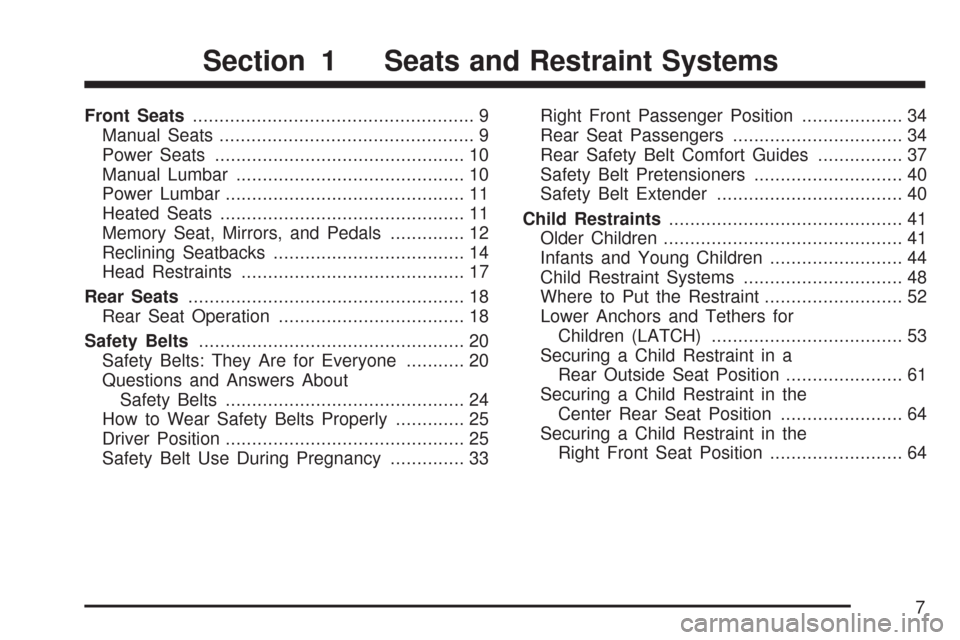
Front Seats..................................................... 9
Manual Seats................................................ 9
Power Seats............................................... 10
Manual Lumbar........................................... 10
Power Lumbar............................................. 11
Heated Seats.............................................. 11
Memory Seat, Mirrors, and Pedals.............. 12
Reclining Seatbacks.................................... 14
Head Restraints.......................................... 17
Rear Seats.................................................... 18
Rear Seat Operation................................... 18
Safety Belts.................................................. 20
Safety Belts: They Are for Everyone........... 20
Questions and Answers About
Safety Belts............................................. 24
How to Wear Safety Belts Properly............. 25
Driver Position............................................. 25
Safety Belt Use During Pregnancy.............. 33Right Front Passenger Position................... 34
Rear Seat Passengers................................ 34
Rear Safety Belt Comfort Guides................ 37
Safety Belt Pretensioners............................ 40
Safety Belt Extender................................... 40
Child Restraints............................................ 41
Older Children............................................. 41
Infants and Young Children......................... 44
Child Restraint Systems.............................. 48
Where to Put the Restraint.......................... 52
Lower Anchors and Tethers for
Children (LATCH).................................... 53
Securing a Child Restraint in a
Rear Outside Seat Position...................... 61
Securing a Child Restraint in the
Center Rear Seat Position....................... 64
Securing a Child Restraint in the
Right Front Seat Position......................... 64
Section 1 Seats and Restraint Systems
7
Page 26 of 574
3. Pick up the latch plate and pull the belt across
you. Do not let it get twisted.
The lap-shoulder belt may lock if you pull the
belt across you very quickly. If this happens,
let the belt go back slightly to unlock it.
Then pull the belt across you more slowly.
4. Push the latch plate into the buckle until it
clicks.
Pull up on the latch plate to make sure it is
secure.If the belt is not long enough, seeSafety Belt
Extender on page 40.
Make sure the release button on the buckle is
positioned so you would be able to unbuckle
the safety belt quickly if you ever had to.
5. To make the lap part tight, pull up on the
shoulder belt.
It may be necessary to pull stitching on the
safety belt through the latch plate to fully
tighten the lap belt on smaller occupants.
26
Page 35 of 574
2. Push the latch plate into the buckle until
it clicks.
Pull up on the latch plate to make sure it
is secure.
When the shoulder belt is pulled out all the
way, it will lock. If it does, let it go back all the
way and start again.
If the belt is not long enough, seeSafety Belt
Extender on page 40.
Make sure the release button on the buckle is
positioned so you would be able to unbuckle
the safety belt quickly if you ever had to.
3. To make the lap part tight, pull up on the
shoulder part.
35
Page 40 of 574
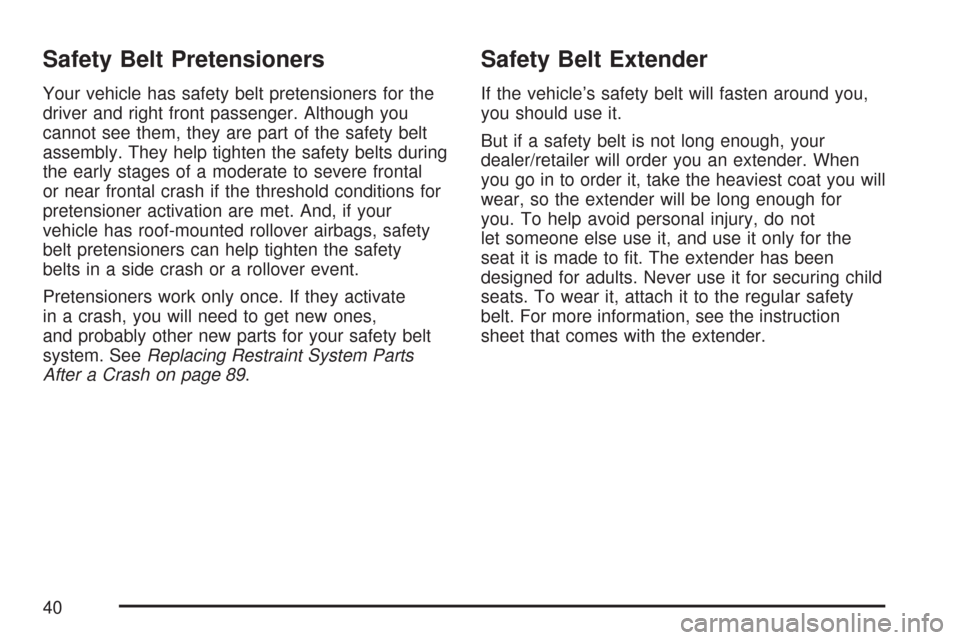
Safety Belt Pretensioners
Your vehicle has safety belt pretensioners for the
driver and right front passenger. Although you
cannot see them, they are part of the safety belt
assembly. They help tighten the safety belts during
the early stages of a moderate to severe frontal
or near frontal crash if the threshold conditions for
pretensioner activation are met. And, if your
vehicle has roof-mounted rollover airbags, safety
belt pretensioners can help tighten the safety
belts in a side crash or a rollover event.
Pretensioners work only once. If they activate
in a crash, you will need to get new ones,
and probably other new parts for your safety belt
system. SeeReplacing Restraint System Parts
After a Crash on page 89.
Safety Belt Extender
If the vehicle’s safety belt will fasten around you,
you should use it.
But if a safety belt is not long enough, your
dealer/retailer will order you an extender. When
you go in to order it, take the heaviest coat you will
wear, so the extender will be long enough for
you. To help avoid personal injury, do not
let someone else use it, and use it only for the
seat it is made to �t. The extender has been
designed for adults. Never use it for securing child
seats. To wear it, attach it to the regular safety
belt. For more information, see the instruction
sheet that comes with the extender.
40
Page 45 of 574
{CAUTION:
People should never hold a baby in their
arms while riding in a vehicle. A baby
does not weigh much — until a crash.
During a crash a baby will become so
heavy it is not possible to hold it. For
example, in a crash at only 25 mph
(40 km/h), a 12 lb (5.5 kg) baby will
suddenly become a 240 lb (110 kg) force
on a person’s arms. A baby should be
secured in an appropriate restraint.
45
Page 47 of 574
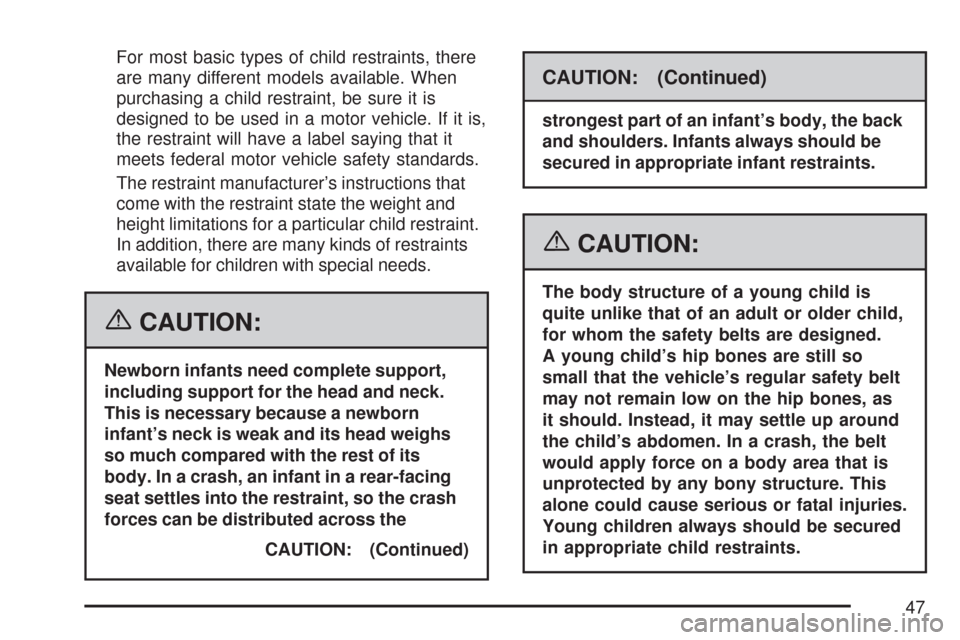
For most basic types of child restraints, there
are many different models available. When
purchasing a child restraint, be sure it is
designed to be used in a motor vehicle. If it is,
the restraint will have a label saying that it
meets federal motor vehicle safety standards.
The restraint manufacturer’s instructions that
come with the restraint state the weight and
height limitations for a particular child restraint.
In addition, there are many kinds of restraints
available for children with special needs.
{CAUTION:
Newborn infants need complete support,
including support for the head and neck.
This is necessary because a newborn
infant’s neck is weak and its head weighs
so much compared with the rest of its
body. In a crash, an infant in a rear-facing
seat settles into the restraint, so the crash
forces can be distributed across the
CAUTION: (Continued)
CAUTION: (Continued)
strongest part of an infant’s body, the back
and shoulders. Infants always should be
secured in appropriate infant restraints.
{CAUTION:
The body structure of a young child is
quite unlike that of an adult or older child,
for whom the safety belts are designed.
A young child’s hip bones are still so
small that the vehicle’s regular safety belt
may not remain low on the hip bones, as
it should. Instead, it may settle up around
the child’s abdomen. In a crash, the belt
would apply force on a body area that is
unprotected by any bony structure. This
alone could cause serious or fatal injuries.
Young children always should be secured
in appropriate child restraints.
47
Page 50 of 574
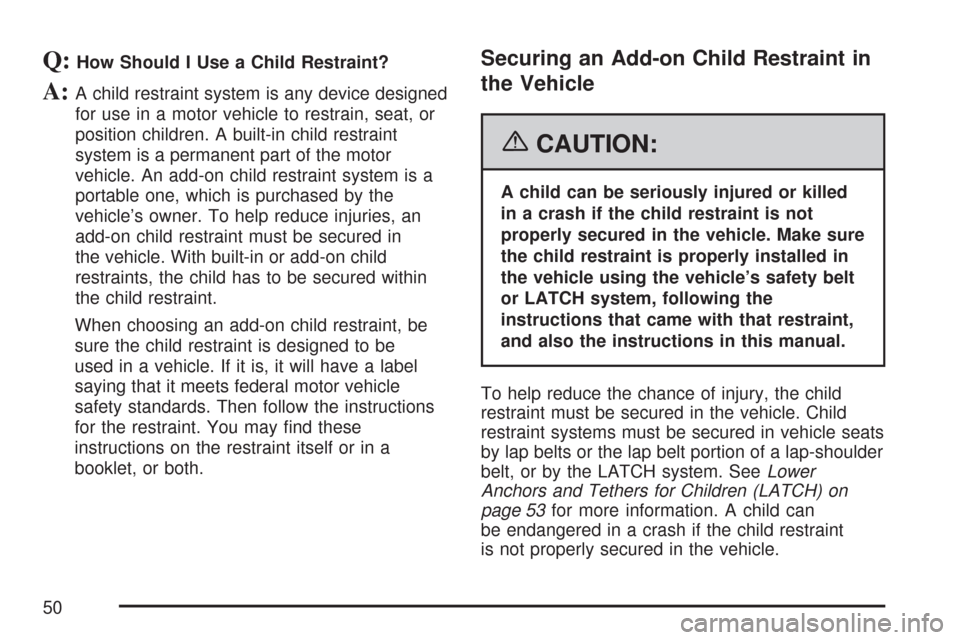
Q:How Should I Use a Child Restraint?
A:A child restraint system is any device designed
for use in a motor vehicle to restrain, seat, or
position children. A built-in child restraint
system is a permanent part of the motor
vehicle. An add-on child restraint system is a
portable one, which is purchased by the
vehicle’s owner. To help reduce injuries, an
add-on child restraint must be secured in
the vehicle. With built-in or add-on child
restraints, the child has to be secured within
the child restraint.
When choosing an add-on child restraint, be
sure the child restraint is designed to be
used in a vehicle. If it is, it will have a label
saying that it meets federal motor vehicle
safety standards. Then follow the instructions
for the restraint. You may �nd these
instructions on the restraint itself or in a
booklet, or both.
Securing an Add-on Child Restraint in
the Vehicle
{CAUTION:
A child can be seriously injured or killed
in a crash if the child restraint is not
properly secured in the vehicle. Make sure
the child restraint is properly installed in
the vehicle using the vehicle’s safety belt
or LATCH system, following the
instructions that came with that restraint,
and also the instructions in this manual.
To help reduce the chance of injury, the child
restraint must be secured in the vehicle. Child
restraint systems must be secured in vehicle seats
by lap belts or the lap belt portion of a lap-shoulder
belt, or by the LATCH system. SeeLower
Anchors and Tethers for Children (LATCH) on
page 53for more information. A child can
be endangered in a crash if the child restraint
is not properly secured in the vehicle.
50
Page 51 of 574
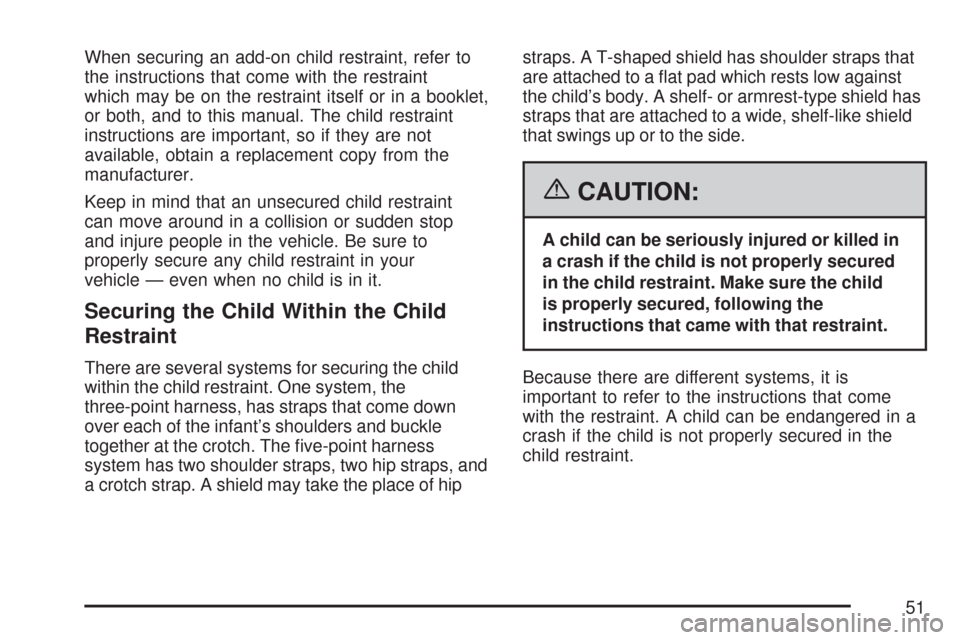
When securing an add-on child restraint, refer to
the instructions that come with the restraint
which may be on the restraint itself or in a booklet,
or both, and to this manual. The child restraint
instructions are important, so if they are not
available, obtain a replacement copy from the
manufacturer.
Keep in mind that an unsecured child restraint
can move around in a collision or sudden stop
and injure people in the vehicle. Be sure to
properly secure any child restraint in your
vehicle — even when no child is in it.
Securing the Child Within the Child
Restraint
There are several systems for securing the child
within the child restraint. One system, the
three-point harness, has straps that come down
over each of the infant’s shoulders and buckle
together at the crotch. The �ve-point harness
system has two shoulder straps, two hip straps, and
a crotch strap. A shield may take the place of hipstraps. A T-shaped shield has shoulder straps that
are attached to a �at pad which rests low against
the child’s body. A shelf- or armrest-type shield has
straps that are attached to a wide, shelf-like shield
that swings up or to the side.
{CAUTION:
A child can be seriously injured or killed in
a crash if the child is not properly secured
in the child restraint. Make sure the child
is properly secured, following the
instructions that came with that restraint.
Because there are different systems, it is
important to refer to the instructions that come
with the restraint. A child can be endangered in a
crash if the child is not properly secured in the
child restraint.
51